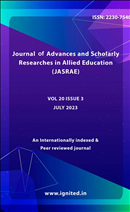Dhar, District of Madhya Pradesh: A Geographical Analysis of Its Native Tribal Population
Keywords:
Dhar, Madhya Pradesh, geographical analysis, native tribal population, population distribution, agricultural productivity, land resource strain, population census, density, gender ratio, rural regions, urban areas, agriculture, ecology, terrain, soil, weather, arable land, water storage, rainfall, undulating terrain, erosion-prone soil, cultivationAbstract
Humans accelerate evolution. With his abilities, knowledge, and proactive attitude, heconverts raw resources into completed items that satisfy his demands. Producers may increase outputand growth. This is efficient, tech-savvy, and fundraising. Consumption is his job while buying.Production and consumption skills strengthen mind and body. People manage the economy andenvironment. The distribution of these clusters affects growth. One must comprehend human features tounderstand a place's evolution. This paradigm has examined demographic issues impacting agriculturalproductivity. Land resource strain is assessed by population distribution, particularly in rural areas. Bestperson allocation is desired. Geographic factors that enhanced population are examined next. Apopulation's cultural features affect labour force quality and quantity.In 2011, the Dhar population was 21,84,672, or about 3 of the state. The population census ranks thisdistrict eighth in Madhya Pradesh by density. The investigated region contained 268 people per squarekilometre, above the state average of 236. This 8,153-square-kilometer area makes up 2.64 of the state.The global population is 10,70,405 women and 11,14,267 men. Comprise the population. Thismunicipality has 961 women per 1000 males, above the state average of 930. The ratios above stateaverage. 83.88 percent reside in rural regions, 16.12 percent in cities.Stochastic distributions exist in urban and rural areas. More than 77.71 work in agriculture. Populationis 83.87 percent rural. Ecology affects agriculture's physiological processes and spatial maturation. It'simportant to have suitable land. Terrain, soil, and weather determine region suitability. Thus, arable land,water storage, and rainfall support large populations. Small populations live on undulating, scatteredterrain with poor, erosion-prone soil unsuitable for cultivation.References
Sharma, S.K., 1992, Resource utilization andDevelopmentA Perspective Study of Madhya Pradesh, India, New Delhi, Northern Book Centre, pp.21,24.
F.A.O., 1993, "Integration of Population Factors into Agricultural and Rural Development Policies : Future Needs in Population Policy and programmes, New York, United Nations, pp.229-234.
Smith, T.L., 1966, Fundamentals of PopulationStudy, New York, Lippincott, p.81.
Tiwari, V.K., 1979, Population of Betul-Chhindwara Plateau - A Geographical Analysis, Unpublished Ph.D. Thesis, Sagar University, Sagar, pp.11920, 141-144.











